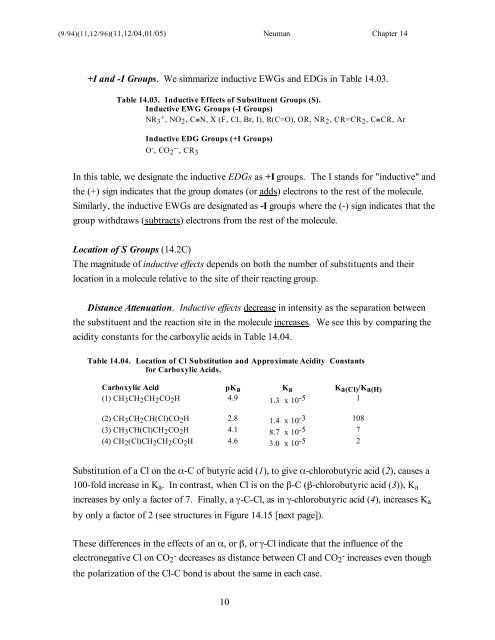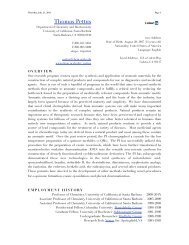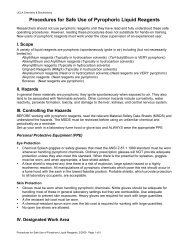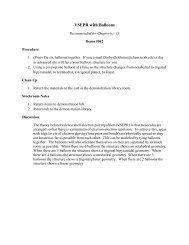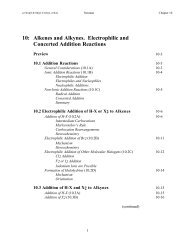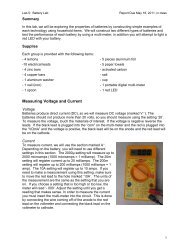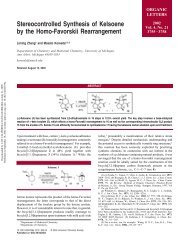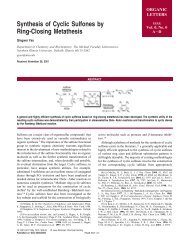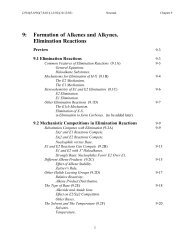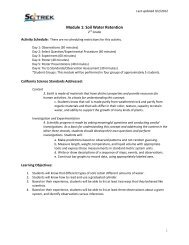14: Substituent Effects
14: Substituent Effects
14: Substituent Effects
Create successful ePaper yourself
Turn your PDF publications into a flip-book with our unique Google optimized e-Paper software.
(9/94)(11,12/96)(11,12/04,01/05) Neuman Chapter <strong>14</strong><br />
+I and -I Groups. We simmarize inductive EWGs and EDGs in Table <strong>14</strong>.03.<br />
Table <strong>14</strong>.03. Inductive <strong>Effects</strong> of <strong>Substituent</strong> Groups (S).<br />
Inductive EWG Groups (-I Groups)<br />
NR3 + , NO2, C≡N, X (F, Cl, Br, I), R(C=O), OR, NR2, CR=CR2, C≡CR, Ar<br />
Inductive EDG Groups (+I Groups)<br />
O - , CO2 -- , CR3<br />
In this table, we designate the inductive EDGs as +I groups. The I stands for "inductive" and<br />
the (+) sign indicates that the group donates (or adds) electrons to the rest of the molecule.<br />
Similarly, the inductive EWGs are designated as -I groups where the (-) sign indicates that the<br />
group withdraws (subtracts) electrons from the rest of the molecule.<br />
Location of S Groups (<strong>14</strong>.2C)<br />
The magnitude of inductive effects depends on both the number of substituents and their<br />
location in a molecule relative to the site of their reacting group.<br />
Distance Attenuation. Inductive effects decrease in intensity as the separation between<br />
the substituent and the reaction site in the molecule increases. We see this by comparing the<br />
acidity constants for the carboxylic acids in Table <strong>14</strong>.04.<br />
Table <strong>14</strong>.04. Location of Cl Substitution and Approximate Acidity Constants<br />
for Carboxylic Acids.<br />
Carboxylic Acid pKa Ka Ka(Cl)/Ka(H)<br />
(1) CH3CH2CH2CO2H 4.9 1.3 x 10 -5 1<br />
(2) CH3CH2CH(Cl)CO2H 2.8 1.4 x 10 -3 108<br />
(3) CH3CH(Cl)CH2CO2H 4.1 8.7 x 10 -5 7<br />
(4) CH2(Cl)CH2CH2CO2H 4.6 3.0 x 10 -5 2<br />
Substitution of a Cl on the α-C of butyric acid (1), to give α-chlorobutyric acid (2), causes a<br />
100-fold increase in Ka. In contrast, when Cl is on the β-C (β-chlorobutyric acid (3)), Ka<br />
increases by only a factor of 7. Finally, a γ-C-Cl, as in γ-chlorobutyric acid (4), increases Ka<br />
by only a factor of 2 (see structures in Figure <strong>14</strong>.15 [next page]).<br />
These differences in the effects of an α, or β, or γ-Cl indicate that the influence of the<br />
electronegative Cl on CO2 - decreases as distance between Cl and CO2 - increases even though<br />
the polarization of the Cl-C bond is about the same in each case.<br />
10


